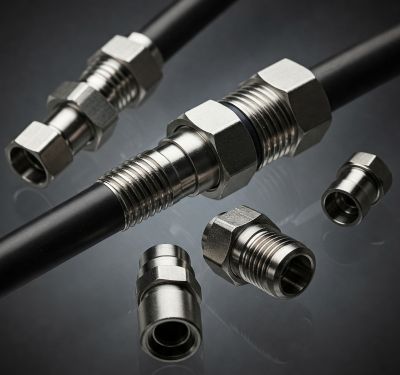Hydraulic systems are essential in a wide range of industries—from construction and agriculture to aerospace and manufacturing. These systems rely on the controlled movement of pressurized fluids to perform heavy-duty tasks. In high-pressure environments, even the smallest leak or failure in the connection points can lead to system inefficiencies, safety hazards, or costly downtime.
That’s where flare connections come in. These fittings play a crucial role in maintaining the integrity and performance of hydraulic systems operating under high pressure. In this blog post, we’ll explore how flare fittings contribute to reliability, safety, and efficiency in demanding hydraulic applications.
What Are Flare Connections?
A flare connection is a type of mechanical fitting used to connect tubes in hydraulic systems. The key feature of a flare fitting is its conical seal—formed by flaring the end of a tube to match the angle of the fitting, allowing for a tight, pressure-resistant joint.
Common Materials Used
Flare fittings are commonly made from durable, corrosion-resistant materials, such as:
-
Stainless steel (ideal for high-pressure or corrosive environments)
-
Brass (commonly used in lower-pressure or general-purpose systems)
-
Aluminum (lighter applications)
Flare Angles
-
37° flare fittings (typically used in hydraulic systems, as specified by SAE J514 standards)
-
45° flare fittings (more common in plumbing or low-pressure applications)
How They Compare
Unlike compression or push-to-connect fittings, flare connections offer a more secure and reusable sealing method. They are preferred in high-pressure applications due to their ability to form a metal-to-metal seal that withstands extreme conditions.
Importance of High-Pressure Compatibility
Hydraulic systems can operate under pressures ranging from 1,000 to over 6,000 PSI, depending on the application. At these levels, even a minor fitting weakness can lead to catastrophic failure.
Not All Fittings Are Created Equal
Many common fitting types are not designed for high-pressure service. Rubber seals or plastic components can degrade, leak, or burst. Flare fittings, by contrast, are metal-on-metal, which provides:
-
Greater structural strength
-
Resistance to seal degradation
-
Long-term pressure retention
Designed for Pressure
Flare connections are specifically engineered to handle high PSI levels. They often meet industry standards like:
-
SAE J514 – covering 37° flare fittings
-
ISO 8434-2 – international standards for hydraulic fittings
These standards ensure performance consistency and safe operation under high-pressure conditions.
Advantages of Flare Connections in Hydraulic Systems
Flare fittings provide multiple benefits that make them ideal for demanding environments:
1. Leak Resistance
The metal-to-metal seal provides a tight, reliable connection that minimizes the risk of fluid leakage, even under fluctuating pressures and temperatures.
2. Durability
Flare connections perform well under mechanical stress and vibration, which is common in mobile and industrial hydraulic equipment.
3. Reusability
These fittings can be disassembled and reassembled without compromising the integrity of the seal, making them cost-effective and convenient for maintenance.
4. Corrosion Resistance
When made from the right materials (like stainless steel), flare fittings offer excellent resistance to environmental and chemical corrosion.
Installation Best Practices
Correct installation is key to ensuring the performance and longevity of flare connections.
Tube Preparation
-
Use a high-quality flaring tool
-
Ensure the tubing is cut cleanly and squarely
-
Deburr the inside and outside of the tube before flaring
Proper Torque and Alignment
-
Tighten to the manufacturer’s recommended torque
-
Misalignment can cause uneven sealing and leaks
Avoid Over-Tightening
Too much torque can crack the flare or damage the fitting, while under-tightening may lead to leakage.
Inspection and Maintenance
-
Check for signs of wear or fatigue regularly
-
Re-flare tubing if any surface imperfections or cracks are found
Common Issues and Troubleshooting
Signs of a Failing Flare Connection
-
Visible fluid leaks around the fitting
-
Drops in system pressure
-
Vibration-induced loosening
Common Causes
- Incorrect flare angle
- Tube cracking due to poor flare technique
- Over- or under-tightening
Solutions
-
Re-flare or replace damaged tubing
-
Use a torque wrench for consistent tightening
-
Ensure proper alignment before tightening
FAQs
Q: What’s the difference between 37° and 45° flare fittings?
A: 37° fittings (SAE standard) are used in hydraulic systems, while 45° fittings are more common in refrigeration and low-pressure plumbing.
Q: Can I reuse a flare fitting?
A: Yes, but inspect it for damage or deformation before reuse.
Q: What’s the maximum pressure a flare fitting can handle?
A: It depends on the fitting size and material, but stainless steel flare fittings can often handle over 6,000 PSI.
Conclusion
Flare connections are an essential component in the reliability and safety of high-pressure hydraulic systems. Their ability to form a strong, leak-free seal and withstand vibration and pressure cycling makes them a preferred choice across many industries.
Choosing the correct fittings, installing them properly, and maintaining them regularly can dramatically extend the life of your hydraulic system and prevent costly breakdowns. For any high-pressure application, flare fittings offer the peace of mind that comes with proven performance.
Post time: May-08-2025


